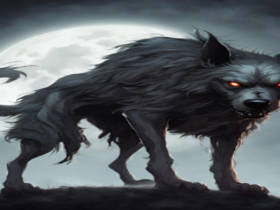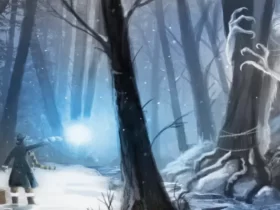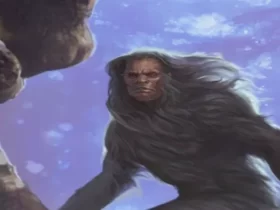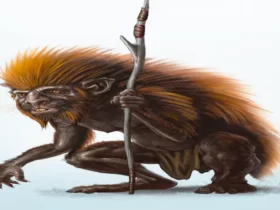The Squonk, also known as Lacrimacorpus dissolvens, is a creature from folklore that is said to inhabit the Hemlock forest in the northern region of Pennsylvania. It is a frightening and mythical beast that has been part of local lore since the late 1800s, a time when Pennsylvania was a significant player in the timber and hunting industries.
The first written record of Squonks can be traced back to a publication authored by William T. Cox, titled “Fearsome Creatures of the Lumberwoods, With a Few Desert and Mountain Beasts”, which was released in 1910.
Appearance

According to the legend, the Squonk has a hide that is covered in warts and does not fit properly, This causes the Squonk to experience shame about its looks. As a result, The creature is said to devote the majority of its time to crying and avoids being seen. Hunters who have attempted to capture the Squonk have discovered that the creature has the ability to dissolve into a pool of tears and bubbles when cornered. It is said that a man named J. P. Wentling managed to coax a Squonk into a bag, but when he tried to take it home, he discovered that the bag had suddenly become lighter. Upon inspection, he found that the creature had completely dissolved into a liquid form, which was the sad animal’s only remains.
In “Hal Johnson’s” 2015 rendition of the Fearsome Creatures, the Squonk is portrayed as a pig, both physically and in reality. The creature is covered in warts and has cauliflower-shaped ears coated in hair and wax. Its yellow and crooked tusks and rheumy eyes constantly weep tears. The Squonk has four legs, although the right hind leg appears to be transparent, making it seem as though it only has three and a half legs. The creature’s terrifying aspect is that its sorrow is contagious. It is believed to reside in the Pocono Mountains of Pennsylvania. Despite attempts to catch it, such as those by Jean-Paul Wentling, an adversary of “Hal Johnson,” the Squonk remains elusive. Any individual who attempts to capture it meets the same fate as the Squonk and ultimately dissolves into tears, resulting in their death. The Squonk is thought to reproduce through binary fission, and its scientific name is Theristes lachrymosus.
You don’t need to miss this exciting cryptid: Dingonek
“Fearsome Creatures of the Lumberwoods” That Mentions Squonk Cryptid

“Fearsome Creatures of the Lumberwoods, With a Few Desert and Mountain Beasts” is a book written and illustrated by William T. Cox. The book was first published in 1910 by the J.W. Bishop Company and has since become a classic of American folklore and cryptozoology.
The book is a collection of humorous tall tales and legends about bizarre and monstrous creatures that supposedly inhabited the forests of North America. These creatures include the Hodag, a horned and spiky-tailed beast with razor-sharp claws; the Snoligoster, a giant, snail-like creature with multiple rows of teeth; and the Whirling Whimpus, a creature that spins like a top and can uproot trees with its powerful tail.
Cox’s book is known for its elaborate and colorful illustrations, which bring the creatures to life in vivid detail. Although the creatures described in the book are purely fictional, they reflect the rich tradition of folklore and storytelling that has long been a part of North American culture.
In his book, Cox wrote about a creature that he named Lacrimacorpus dissolvens aka Squonk. According to him, it was an unattractive animal that was aware of its own ugliness. The creature was originally found in high plains with desert vegetation, but as the environment changed to swampy and lake-dotted areas, the creature was forced to move into the water. The squonk, as Cox called it, had a low intelligence and wandered around the unfamiliar marshes looking for food. Over time, it developed webbing between its toes, but only on its left feet, causing it to swim in circles and preventing it from returning to shore. As a result, many squonks died of starvation, which is evident from fossil bones found in lake bottoms. Nowadays, the squonk is only found in the hemlock forests of Pennsylvania.
Cox described the squonk as a shy and reclusive creature that was active during dawn and dusk. It had a loose, ill-fitting skin that was covered in warts and was always unhappy, often weeping due to its unattractive appearance. The creature was known to leave a trail of tears, which could be used to track it. The squonk was most commonly found in the hemlock forests of Pennsylvania and was rarely seen outside of the state.
According to Tryon’s embellishment of Cox’s description, the squonk was a very melancholy creature due to its warty and misfitting skin. It had a limited range and was rarely seen outside of Pennsylvania. The squonk was most active during twilight and dusk, and it was said to be the most morbid of all beasts.
Skilled hunters who are able to track the squonk can follow its trail of tears, as the creature weeps constantly. In situations where the squonk is cornered or feels frightened and unable to escape, it may even dissolve into tears.
Hunters looking to catch the squonk are most likely to find success on cold, moonlit nights, as the tears are shed slowly and the animal is less inclined to move around. During this time, the squonk may be heard weeping under the branches of dark hemlock trees.
According to a story, Mr. J.P. Wentling had an unsuccessful encounter with a squonk near Mont Alto in Pennsylvania. Wentling was able to capture the squonk by imitating it and luring it into a sack. However, as he was carrying the sack home, the burden suddenly lightened, and the weeping of the squonk ceased. When he opened the sack, he found nothing inside except for tears and bubbles, indicating that the squonk had dissolved into tears to escape capture.
Similar Read: Yowie Monster
Are Squonk Real Or Just An Imagination?

The term “fearsome critters’ ‘ refers to mythical or folkloric creatures that were believed to live in the wilderness of North America and were often featured in early lumberjack tales. These creatures were a significant part of the oral tradition in North American lumber camps during the early 1900s and continue to be so to this day.
The character of fearsome critters was typically more amusing than scary, as they were often used as a way to pass the time or tease new members of the group. The tales were often inspired by strange sights or sounds encountered in the wilderness or by campers who had become lost. Lumberjacks would often swap stories as they traveled between camps, spreading these myths throughout the continent. While many of the fearsome critters were created purely through exaggeration, some were used seriously or jokingly to explain unexplained phenomena.
Wrapping Up
Fearsome critters were often described as having exaggerated physical features that pushed the boundaries of biomechanics, such as the tripodero and snoligoster, which were more akin to mechanical apparatuses than animals. Other creatures like the hugag and sidehill gouger were portrayed as playing on applied physics rather than fanciful inspiration. While many scholars approach these myths from a naturalist perspective, detailing their range, behavior, and appearance, it’s important to note that there is often little consensus on the specifics of each creature, and some myths have clear contradictions. For example, the wampus cat is described differently in Vance Randolph’s We Always Lie to Strangers and Henry H. Tryon’s Fearsome Critters, with Tryon portraying a cat with pantographic forelimbs and Randolph depicting it as a supernatural aquatic panther.
If you thought Squonk exists and explorers have real sightings, you can drop us an email with the references or real testimonials. We will further like to update this cryptid research.





